Target's India Opportunity: A Strategic Global Marketing Plan
VerifiedAdded on 2023/06/09
|24
|3771
|463
Report
AI Summary
This report provides a strategic analysis of Target Corporation's potential expansion into the Indian market. It includes a market analysis, organizational analysis, macro-environmental analysis using PESTLE and Porter's Five Forces, and a SWOT analysis. The report identifies market size, growth rates, barriers, and drivers in the Indian retail sector. It examines Target's competitive advantages, value chain, and positioning relative to competitors like Kmart, H&M and Zara. The analysis considers economic, political, socio-cultural, technological, legal, and environmental factors impacting Target's entry into India. The report concludes with considerations for Target to ensure a successful expansion into the Asian market. Desklib provides this document and many other solved assignments for students.
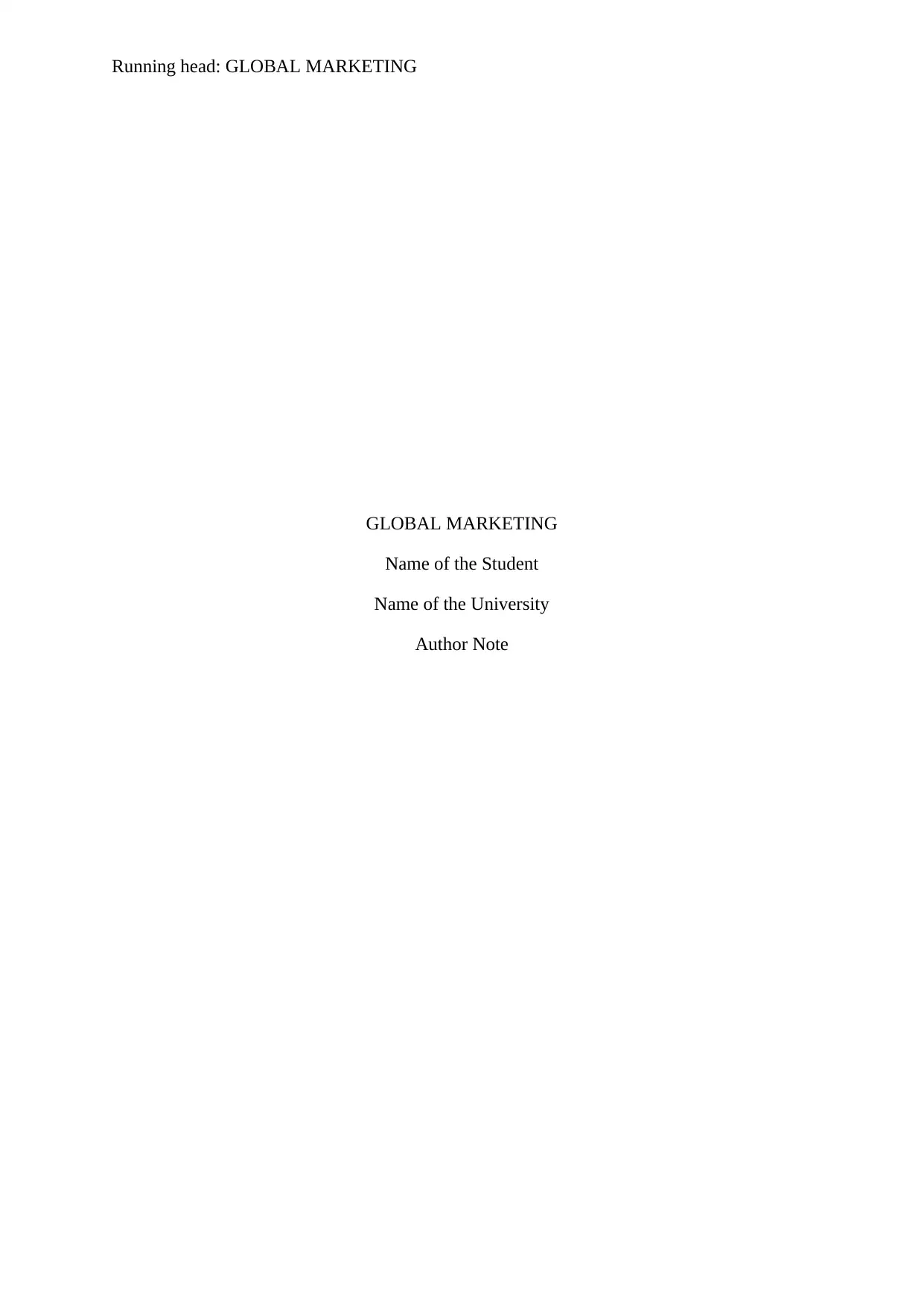
Running head: GLOBAL MARKETING
GLOBAL MARKETING
Name of the Student
Name of the University
Author Note
GLOBAL MARKETING
Name of the Student
Name of the University
Author Note
Paraphrase This Document
Need a fresh take? Get an instant paraphrase of this document with our AI Paraphraser
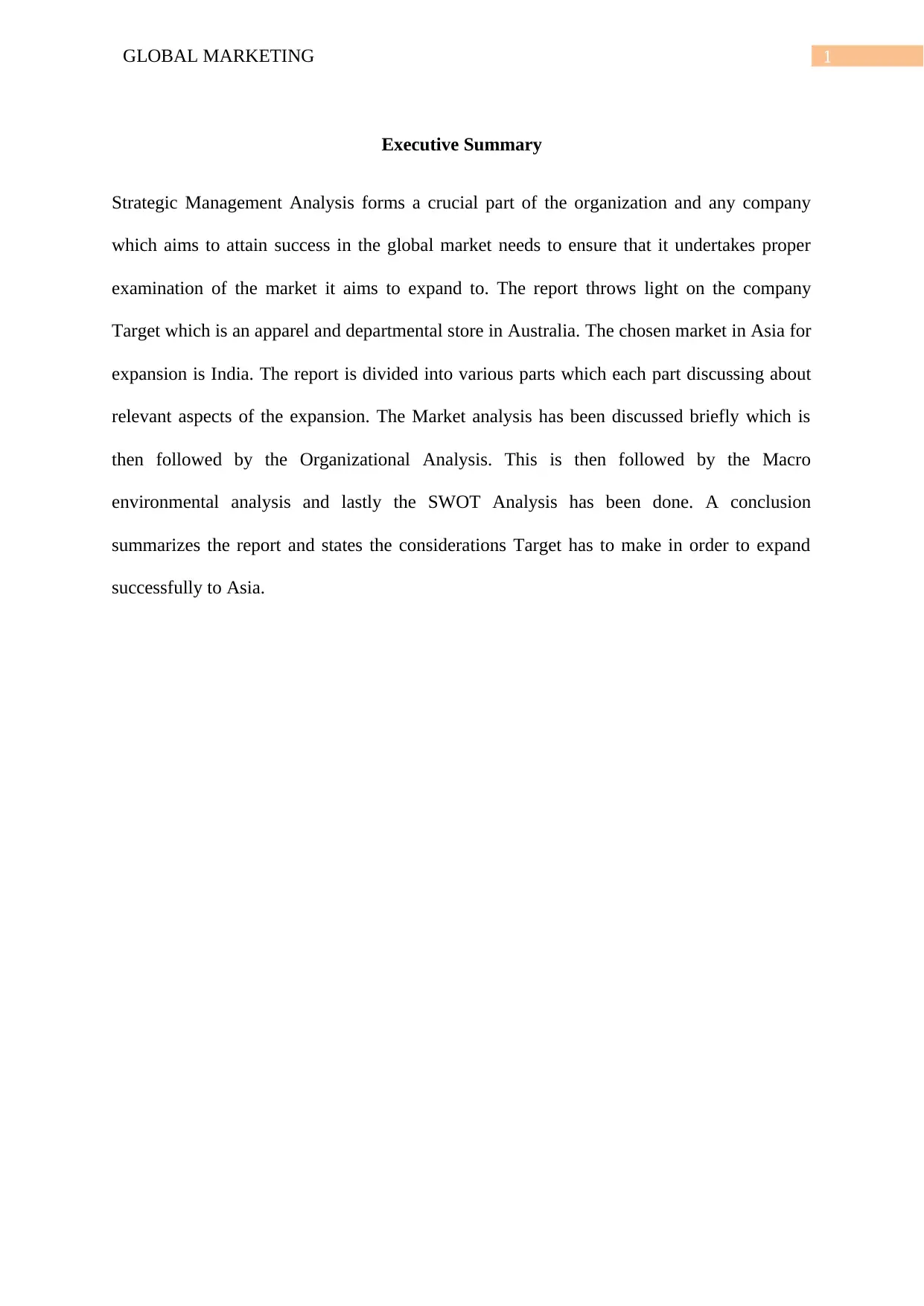
1GLOBAL MARKETING
Executive Summary
Strategic Management Analysis forms a crucial part of the organization and any company
which aims to attain success in the global market needs to ensure that it undertakes proper
examination of the market it aims to expand to. The report throws light on the company
Target which is an apparel and departmental store in Australia. The chosen market in Asia for
expansion is India. The report is divided into various parts which each part discussing about
relevant aspects of the expansion. The Market analysis has been discussed briefly which is
then followed by the Organizational Analysis. This is then followed by the Macro
environmental analysis and lastly the SWOT Analysis has been done. A conclusion
summarizes the report and states the considerations Target has to make in order to expand
successfully to Asia.
Executive Summary
Strategic Management Analysis forms a crucial part of the organization and any company
which aims to attain success in the global market needs to ensure that it undertakes proper
examination of the market it aims to expand to. The report throws light on the company
Target which is an apparel and departmental store in Australia. The chosen market in Asia for
expansion is India. The report is divided into various parts which each part discussing about
relevant aspects of the expansion. The Market analysis has been discussed briefly which is
then followed by the Organizational Analysis. This is then followed by the Macro
environmental analysis and lastly the SWOT Analysis has been done. A conclusion
summarizes the report and states the considerations Target has to make in order to expand
successfully to Asia.
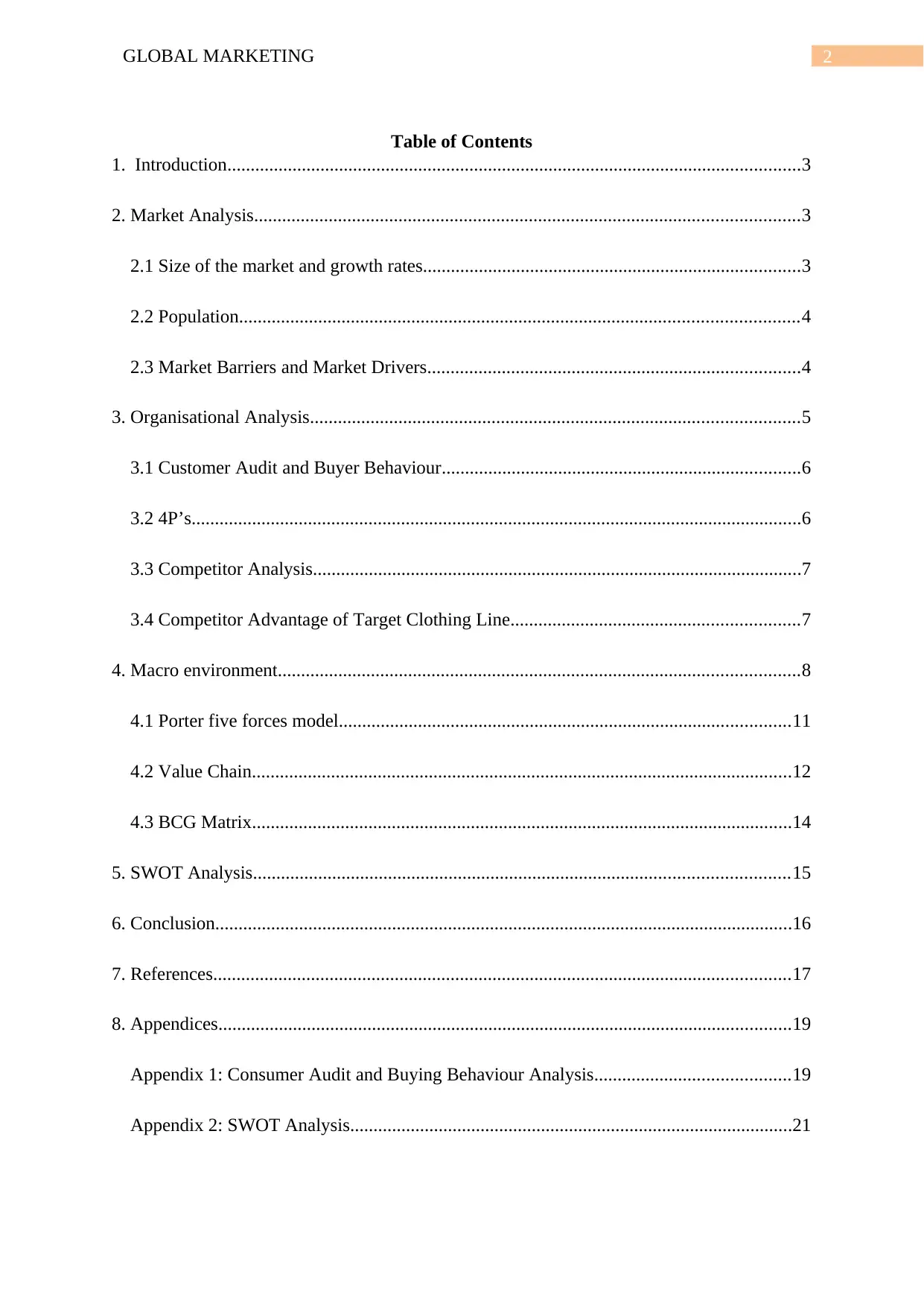
2GLOBAL MARKETING
Table of Contents
1. Introduction...........................................................................................................................3
2. Market Analysis.....................................................................................................................3
2.1 Size of the market and growth rates.................................................................................3
2.2 Population........................................................................................................................4
2.3 Market Barriers and Market Drivers................................................................................4
3. Organisational Analysis.........................................................................................................5
3.1 Customer Audit and Buyer Behaviour.............................................................................6
3.2 4P’s...................................................................................................................................6
3.3 Competitor Analysis.........................................................................................................7
3.4 Competitor Advantage of Target Clothing Line..............................................................7
4. Macro environment................................................................................................................8
4.1 Porter five forces model.................................................................................................11
4.2 Value Chain....................................................................................................................12
4.3 BCG Matrix....................................................................................................................14
5. SWOT Analysis...................................................................................................................15
6. Conclusion............................................................................................................................16
7. References............................................................................................................................17
8. Appendices...........................................................................................................................19
Appendix 1: Consumer Audit and Buying Behaviour Analysis..........................................19
Appendix 2: SWOT Analysis...............................................................................................21
Table of Contents
1. Introduction...........................................................................................................................3
2. Market Analysis.....................................................................................................................3
2.1 Size of the market and growth rates.................................................................................3
2.2 Population........................................................................................................................4
2.3 Market Barriers and Market Drivers................................................................................4
3. Organisational Analysis.........................................................................................................5
3.1 Customer Audit and Buyer Behaviour.............................................................................6
3.2 4P’s...................................................................................................................................6
3.3 Competitor Analysis.........................................................................................................7
3.4 Competitor Advantage of Target Clothing Line..............................................................7
4. Macro environment................................................................................................................8
4.1 Porter five forces model.................................................................................................11
4.2 Value Chain....................................................................................................................12
4.3 BCG Matrix....................................................................................................................14
5. SWOT Analysis...................................................................................................................15
6. Conclusion............................................................................................................................16
7. References............................................................................................................................17
8. Appendices...........................................................................................................................19
Appendix 1: Consumer Audit and Buying Behaviour Analysis..........................................19
Appendix 2: SWOT Analysis...............................................................................................21
⊘ This is a preview!⊘
Do you want full access?
Subscribe today to unlock all pages.

Trusted by 1+ million students worldwide
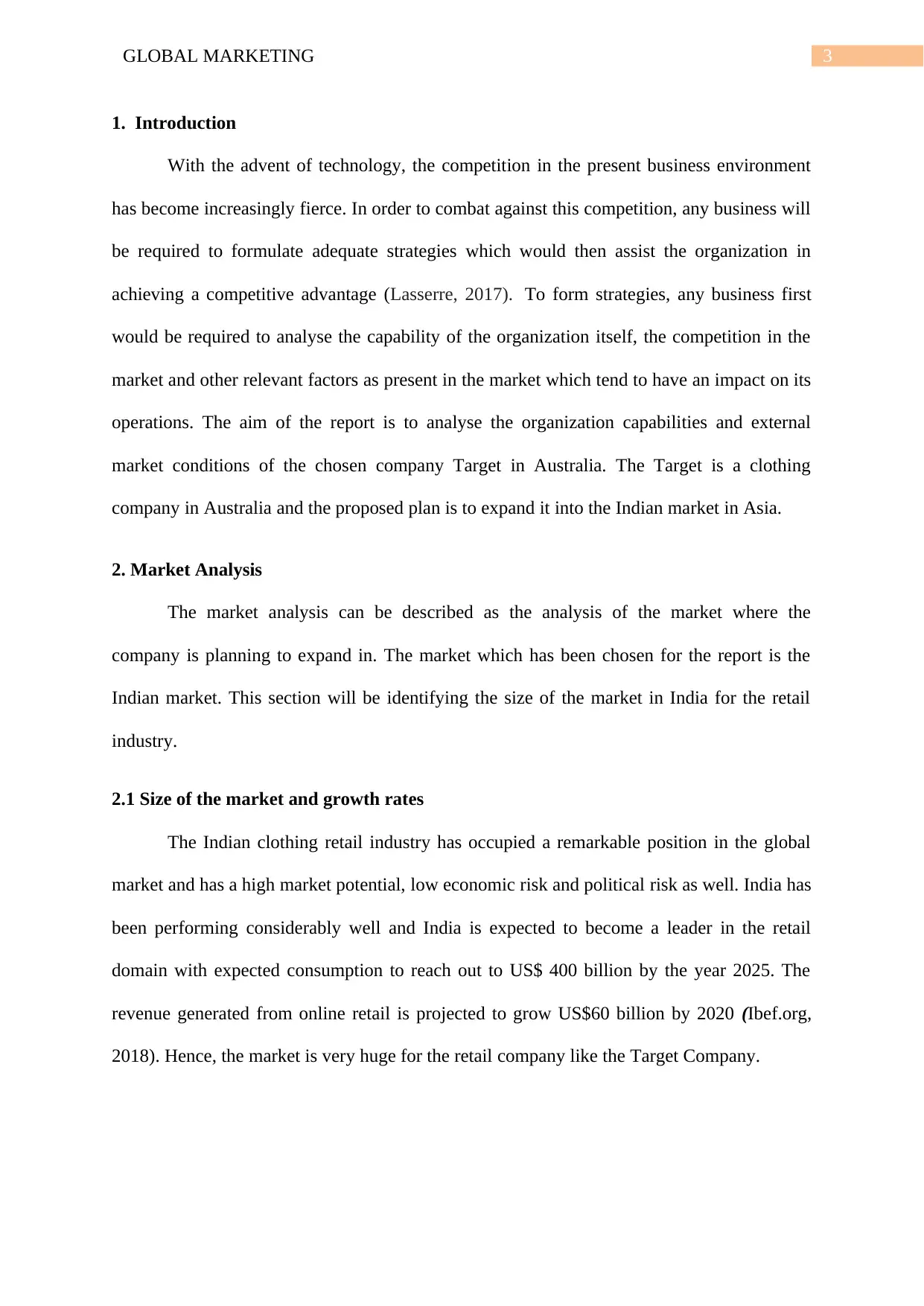
3GLOBAL MARKETING
1. Introduction
With the advent of technology, the competition in the present business environment
has become increasingly fierce. In order to combat against this competition, any business will
be required to formulate adequate strategies which would then assist the organization in
achieving a competitive advantage (Lasserre, 2017). To form strategies, any business first
would be required to analyse the capability of the organization itself, the competition in the
market and other relevant factors as present in the market which tend to have an impact on its
operations. The aim of the report is to analyse the organization capabilities and external
market conditions of the chosen company Target in Australia. The Target is a clothing
company in Australia and the proposed plan is to expand it into the Indian market in Asia.
2. Market Analysis
The market analysis can be described as the analysis of the market where the
company is planning to expand in. The market which has been chosen for the report is the
Indian market. This section will be identifying the size of the market in India for the retail
industry.
2.1 Size of the market and growth rates
The Indian clothing retail industry has occupied a remarkable position in the global
market and has a high market potential, low economic risk and political risk as well. India has
been performing considerably well and India is expected to become a leader in the retail
domain with expected consumption to reach out to US$ 400 billion by the year 2025. The
revenue generated from online retail is projected to grow US$60 billion by 2020 (Ibef.org,
2018). Hence, the market is very huge for the retail company like the Target Company.
1. Introduction
With the advent of technology, the competition in the present business environment
has become increasingly fierce. In order to combat against this competition, any business will
be required to formulate adequate strategies which would then assist the organization in
achieving a competitive advantage (Lasserre, 2017). To form strategies, any business first
would be required to analyse the capability of the organization itself, the competition in the
market and other relevant factors as present in the market which tend to have an impact on its
operations. The aim of the report is to analyse the organization capabilities and external
market conditions of the chosen company Target in Australia. The Target is a clothing
company in Australia and the proposed plan is to expand it into the Indian market in Asia.
2. Market Analysis
The market analysis can be described as the analysis of the market where the
company is planning to expand in. The market which has been chosen for the report is the
Indian market. This section will be identifying the size of the market in India for the retail
industry.
2.1 Size of the market and growth rates
The Indian clothing retail industry has occupied a remarkable position in the global
market and has a high market potential, low economic risk and political risk as well. India has
been performing considerably well and India is expected to become a leader in the retail
domain with expected consumption to reach out to US$ 400 billion by the year 2025. The
revenue generated from online retail is projected to grow US$60 billion by 2020 (Ibef.org,
2018). Hence, the market is very huge for the retail company like the Target Company.
Paraphrase This Document
Need a fresh take? Get an instant paraphrase of this document with our AI Paraphraser
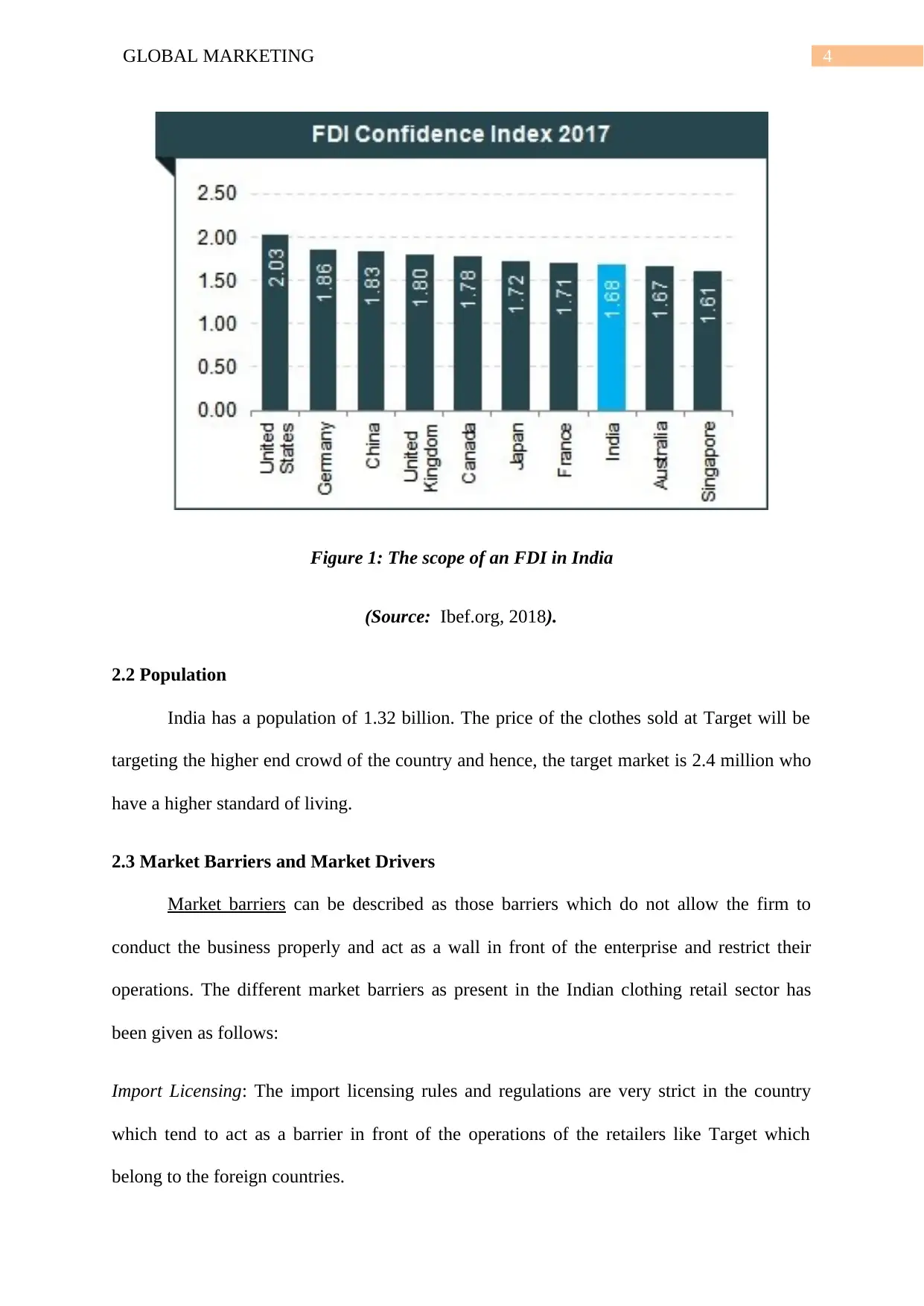
4GLOBAL MARKETING
Figure 1: The scope of an FDI in India
(Source: Ibef.org, 2018).
2.2 Population
India has a population of 1.32 billion. The price of the clothes sold at Target will be
targeting the higher end crowd of the country and hence, the target market is 2.4 million who
have a higher standard of living.
2.3 Market Barriers and Market Drivers
Market barriers can be described as those barriers which do not allow the firm to
conduct the business properly and act as a wall in front of the enterprise and restrict their
operations. The different market barriers as present in the Indian clothing retail sector has
been given as follows:
Import Licensing: The import licensing rules and regulations are very strict in the country
which tend to act as a barrier in front of the operations of the retailers like Target which
belong to the foreign countries.
Figure 1: The scope of an FDI in India
(Source: Ibef.org, 2018).
2.2 Population
India has a population of 1.32 billion. The price of the clothes sold at Target will be
targeting the higher end crowd of the country and hence, the target market is 2.4 million who
have a higher standard of living.
2.3 Market Barriers and Market Drivers
Market barriers can be described as those barriers which do not allow the firm to
conduct the business properly and act as a wall in front of the enterprise and restrict their
operations. The different market barriers as present in the Indian clothing retail sector has
been given as follows:
Import Licensing: The import licensing rules and regulations are very strict in the country
which tend to act as a barrier in front of the operations of the retailers like Target which
belong to the foreign countries.
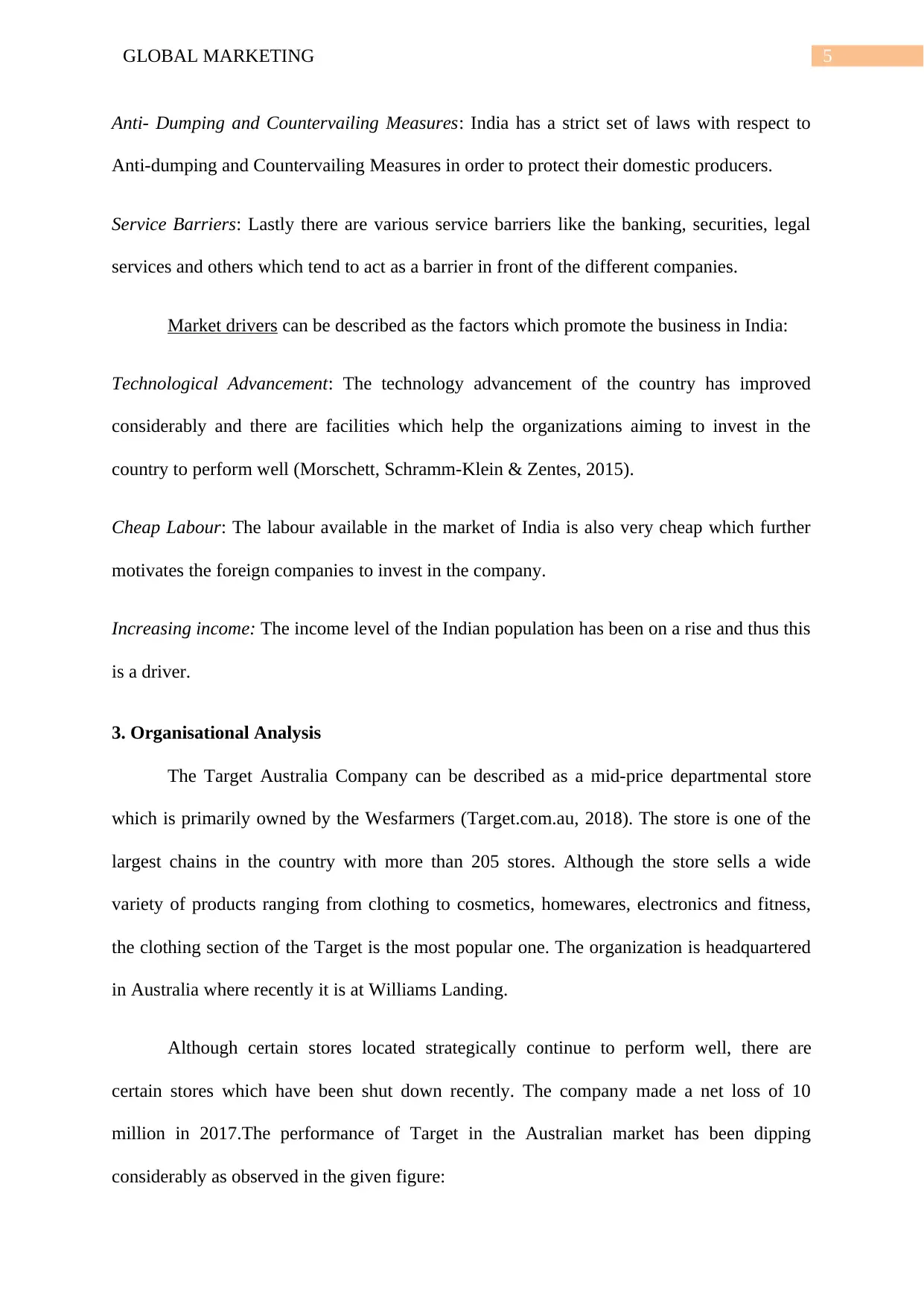
5GLOBAL MARKETING
Anti- Dumping and Countervailing Measures: India has a strict set of laws with respect to
Anti-dumping and Countervailing Measures in order to protect their domestic producers.
Service Barriers: Lastly there are various service barriers like the banking, securities, legal
services and others which tend to act as a barrier in front of the different companies.
Market drivers can be described as the factors which promote the business in India:
Technological Advancement: The technology advancement of the country has improved
considerably and there are facilities which help the organizations aiming to invest in the
country to perform well (Morschett, Schramm-Klein & Zentes, 2015).
Cheap Labour: The labour available in the market of India is also very cheap which further
motivates the foreign companies to invest in the company.
Increasing income: The income level of the Indian population has been on a rise and thus this
is a driver.
3. Organisational Analysis
The Target Australia Company can be described as a mid-price departmental store
which is primarily owned by the Wesfarmers (Target.com.au, 2018). The store is one of the
largest chains in the country with more than 205 stores. Although the store sells a wide
variety of products ranging from clothing to cosmetics, homewares, electronics and fitness,
the clothing section of the Target is the most popular one. The organization is headquartered
in Australia where recently it is at Williams Landing.
Although certain stores located strategically continue to perform well, there are
certain stores which have been shut down recently. The company made a net loss of 10
million in 2017.The performance of Target in the Australian market has been dipping
considerably as observed in the given figure:
Anti- Dumping and Countervailing Measures: India has a strict set of laws with respect to
Anti-dumping and Countervailing Measures in order to protect their domestic producers.
Service Barriers: Lastly there are various service barriers like the banking, securities, legal
services and others which tend to act as a barrier in front of the different companies.
Market drivers can be described as the factors which promote the business in India:
Technological Advancement: The technology advancement of the country has improved
considerably and there are facilities which help the organizations aiming to invest in the
country to perform well (Morschett, Schramm-Klein & Zentes, 2015).
Cheap Labour: The labour available in the market of India is also very cheap which further
motivates the foreign companies to invest in the company.
Increasing income: The income level of the Indian population has been on a rise and thus this
is a driver.
3. Organisational Analysis
The Target Australia Company can be described as a mid-price departmental store
which is primarily owned by the Wesfarmers (Target.com.au, 2018). The store is one of the
largest chains in the country with more than 205 stores. Although the store sells a wide
variety of products ranging from clothing to cosmetics, homewares, electronics and fitness,
the clothing section of the Target is the most popular one. The organization is headquartered
in Australia where recently it is at Williams Landing.
Although certain stores located strategically continue to perform well, there are
certain stores which have been shut down recently. The company made a net loss of 10
million in 2017.The performance of Target in the Australian market has been dipping
considerably as observed in the given figure:
⊘ This is a preview!⊘
Do you want full access?
Subscribe today to unlock all pages.

Trusted by 1+ million students worldwide
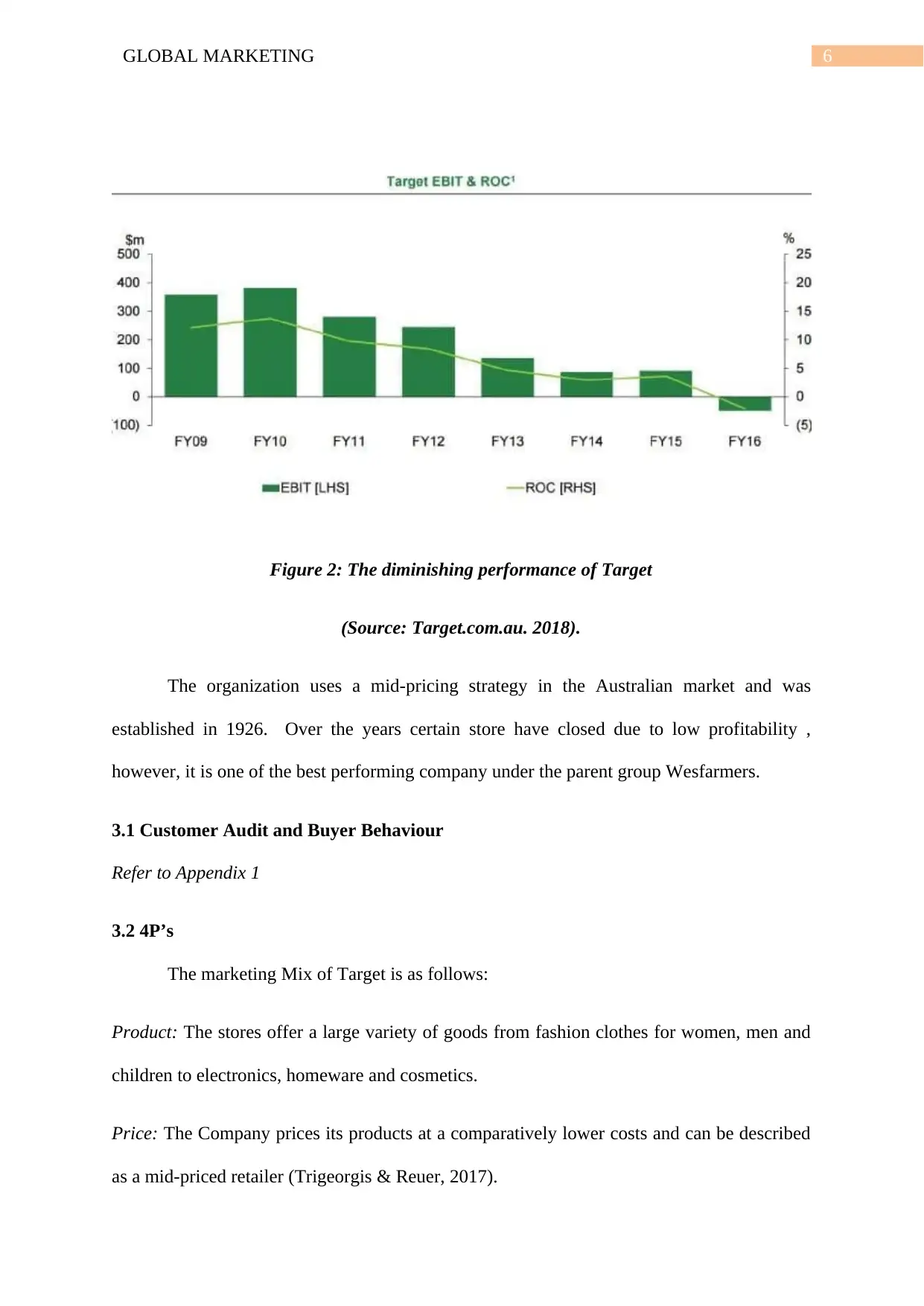
6GLOBAL MARKETING
Figure 2: The diminishing performance of Target
(Source: Target.com.au. 2018).
The organization uses a mid-pricing strategy in the Australian market and was
established in 1926. Over the years certain store have closed due to low profitability ,
however, it is one of the best performing company under the parent group Wesfarmers.
3.1 Customer Audit and Buyer Behaviour
Refer to Appendix 1
3.2 4P’s
The marketing Mix of Target is as follows:
Product: The stores offer a large variety of goods from fashion clothes for women, men and
children to electronics, homeware and cosmetics.
Price: The Company prices its products at a comparatively lower costs and can be described
as a mid-priced retailer (Trigeorgis & Reuer, 2017).
Figure 2: The diminishing performance of Target
(Source: Target.com.au. 2018).
The organization uses a mid-pricing strategy in the Australian market and was
established in 1926. Over the years certain store have closed due to low profitability ,
however, it is one of the best performing company under the parent group Wesfarmers.
3.1 Customer Audit and Buyer Behaviour
Refer to Appendix 1
3.2 4P’s
The marketing Mix of Target is as follows:
Product: The stores offer a large variety of goods from fashion clothes for women, men and
children to electronics, homeware and cosmetics.
Price: The Company prices its products at a comparatively lower costs and can be described
as a mid-priced retailer (Trigeorgis & Reuer, 2017).
Paraphrase This Document
Need a fresh take? Get an instant paraphrase of this document with our AI Paraphraser
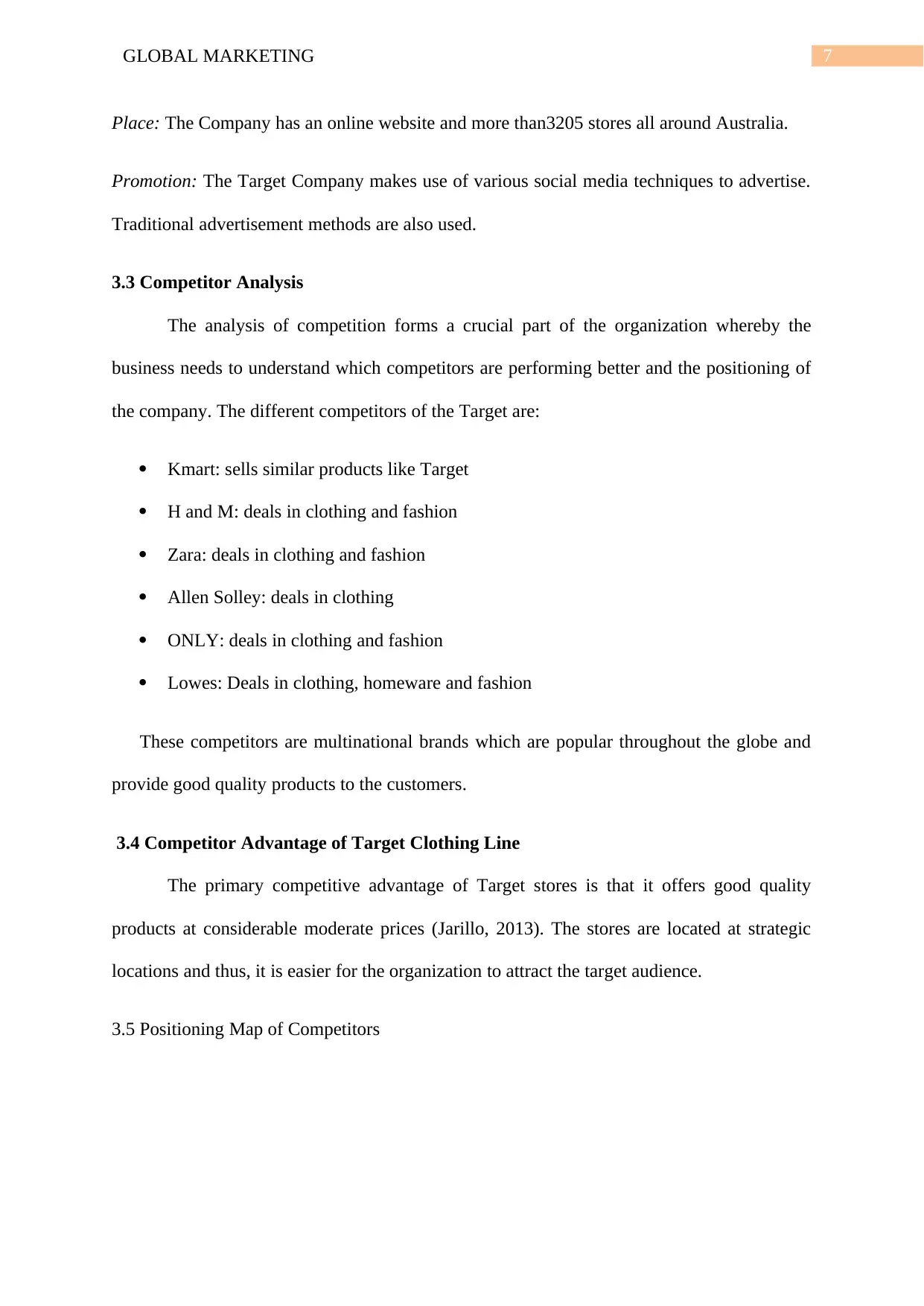
7GLOBAL MARKETING
Place: The Company has an online website and more than3205 stores all around Australia.
Promotion: The Target Company makes use of various social media techniques to advertise.
Traditional advertisement methods are also used.
3.3 Competitor Analysis
The analysis of competition forms a crucial part of the organization whereby the
business needs to understand which competitors are performing better and the positioning of
the company. The different competitors of the Target are:
Kmart: sells similar products like Target
H and M: deals in clothing and fashion
Zara: deals in clothing and fashion
Allen Solley: deals in clothing
ONLY: deals in clothing and fashion
Lowes: Deals in clothing, homeware and fashion
These competitors are multinational brands which are popular throughout the globe and
provide good quality products to the customers.
3.4 Competitor Advantage of Target Clothing Line
The primary competitive advantage of Target stores is that it offers good quality
products at considerable moderate prices (Jarillo, 2013). The stores are located at strategic
locations and thus, it is easier for the organization to attract the target audience.
3.5 Positioning Map of Competitors
Place: The Company has an online website and more than3205 stores all around Australia.
Promotion: The Target Company makes use of various social media techniques to advertise.
Traditional advertisement methods are also used.
3.3 Competitor Analysis
The analysis of competition forms a crucial part of the organization whereby the
business needs to understand which competitors are performing better and the positioning of
the company. The different competitors of the Target are:
Kmart: sells similar products like Target
H and M: deals in clothing and fashion
Zara: deals in clothing and fashion
Allen Solley: deals in clothing
ONLY: deals in clothing and fashion
Lowes: Deals in clothing, homeware and fashion
These competitors are multinational brands which are popular throughout the globe and
provide good quality products to the customers.
3.4 Competitor Advantage of Target Clothing Line
The primary competitive advantage of Target stores is that it offers good quality
products at considerable moderate prices (Jarillo, 2013). The stores are located at strategic
locations and thus, it is easier for the organization to attract the target audience.
3.5 Positioning Map of Competitors
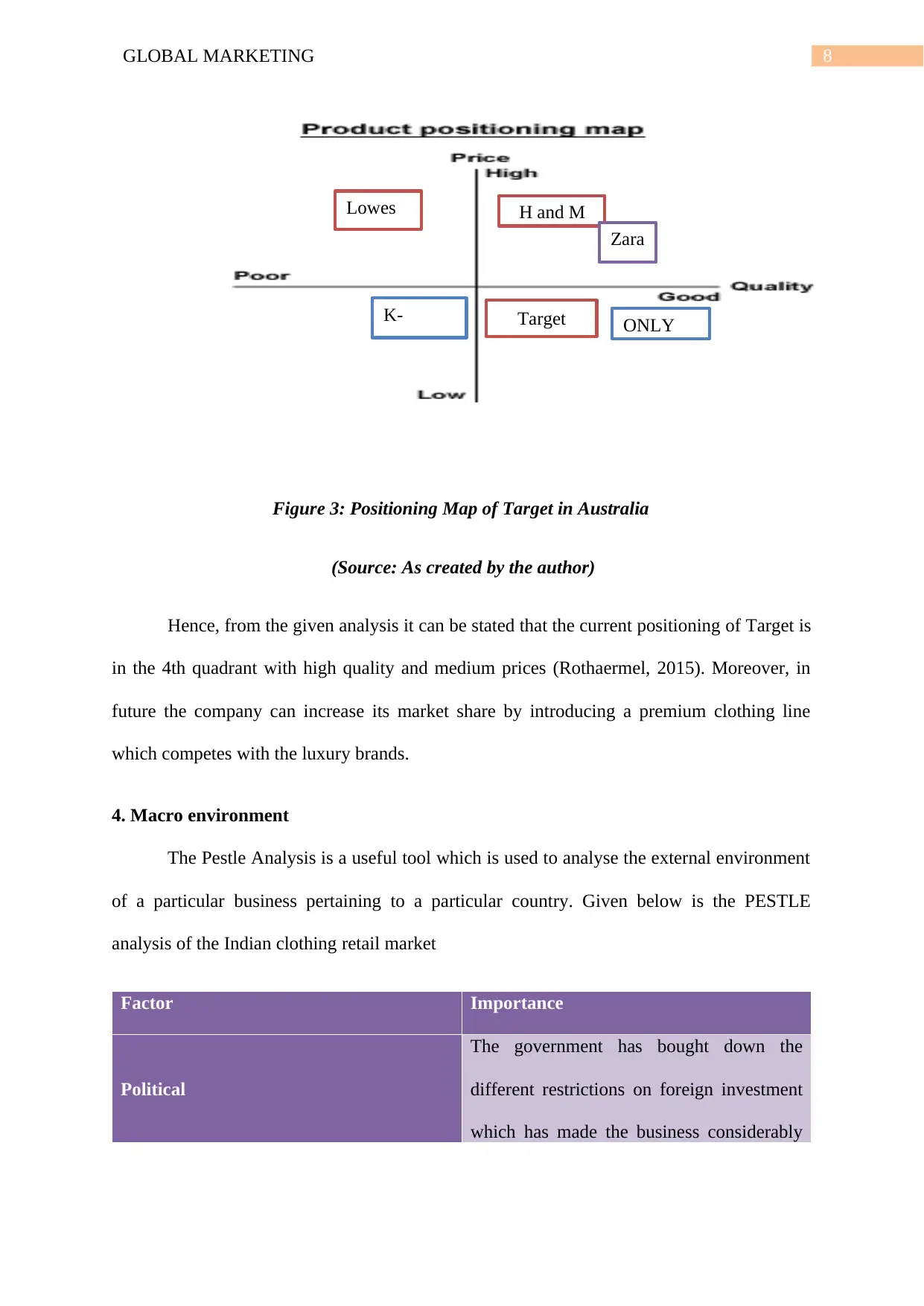
8GLOBAL MARKETING
Figure 3: Positioning Map of Target in Australia
(Source: As created by the author)
Hence, from the given analysis it can be stated that the current positioning of Target is
in the 4th quadrant with high quality and medium prices (Rothaermel, 2015). Moreover, in
future the company can increase its market share by introducing a premium clothing line
which competes with the luxury brands.
4. Macro environment
The Pestle Analysis is a useful tool which is used to analyse the external environment
of a particular business pertaining to a particular country. Given below is the PESTLE
analysis of the Indian clothing retail market
Factor Importance
Political
The government has bought down the
different restrictions on foreign investment
which has made the business considerably
Target
H and M
K-
MART
Zara
Lowes
ONLY
Figure 3: Positioning Map of Target in Australia
(Source: As created by the author)
Hence, from the given analysis it can be stated that the current positioning of Target is
in the 4th quadrant with high quality and medium prices (Rothaermel, 2015). Moreover, in
future the company can increase its market share by introducing a premium clothing line
which competes with the luxury brands.
4. Macro environment
The Pestle Analysis is a useful tool which is used to analyse the external environment
of a particular business pertaining to a particular country. Given below is the PESTLE
analysis of the Indian clothing retail market
Factor Importance
Political
The government has bought down the
different restrictions on foreign investment
which has made the business considerably
Target
H and M
K-
MART
Zara
Lowes
ONLY
⊘ This is a preview!⊘
Do you want full access?
Subscribe today to unlock all pages.

Trusted by 1+ million students worldwide
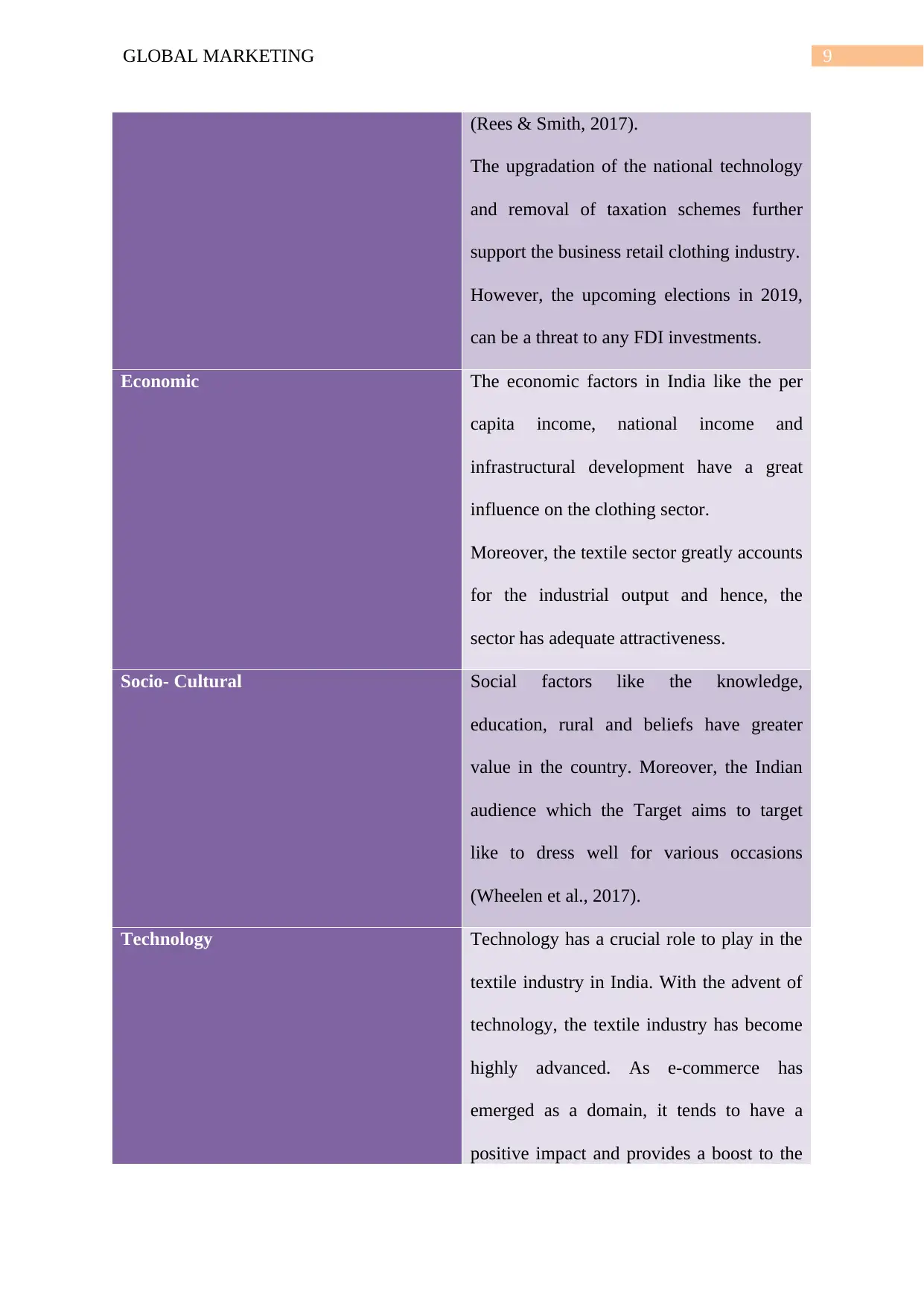
9GLOBAL MARKETING
(Rees & Smith, 2017).
The upgradation of the national technology
and removal of taxation schemes further
support the business retail clothing industry.
However, the upcoming elections in 2019,
can be a threat to any FDI investments.
Economic The economic factors in India like the per
capita income, national income and
infrastructural development have a great
influence on the clothing sector.
Moreover, the textile sector greatly accounts
for the industrial output and hence, the
sector has adequate attractiveness.
Socio- Cultural Social factors like the knowledge,
education, rural and beliefs have greater
value in the country. Moreover, the Indian
audience which the Target aims to target
like to dress well for various occasions
(Wheelen et al., 2017).
Technology Technology has a crucial role to play in the
textile industry in India. With the advent of
technology, the textile industry has become
highly advanced. As e-commerce has
emerged as a domain, it tends to have a
positive impact and provides a boost to the
(Rees & Smith, 2017).
The upgradation of the national technology
and removal of taxation schemes further
support the business retail clothing industry.
However, the upcoming elections in 2019,
can be a threat to any FDI investments.
Economic The economic factors in India like the per
capita income, national income and
infrastructural development have a great
influence on the clothing sector.
Moreover, the textile sector greatly accounts
for the industrial output and hence, the
sector has adequate attractiveness.
Socio- Cultural Social factors like the knowledge,
education, rural and beliefs have greater
value in the country. Moreover, the Indian
audience which the Target aims to target
like to dress well for various occasions
(Wheelen et al., 2017).
Technology Technology has a crucial role to play in the
textile industry in India. With the advent of
technology, the textile industry has become
highly advanced. As e-commerce has
emerged as a domain, it tends to have a
positive impact and provides a boost to the
Paraphrase This Document
Need a fresh take? Get an instant paraphrase of this document with our AI Paraphraser
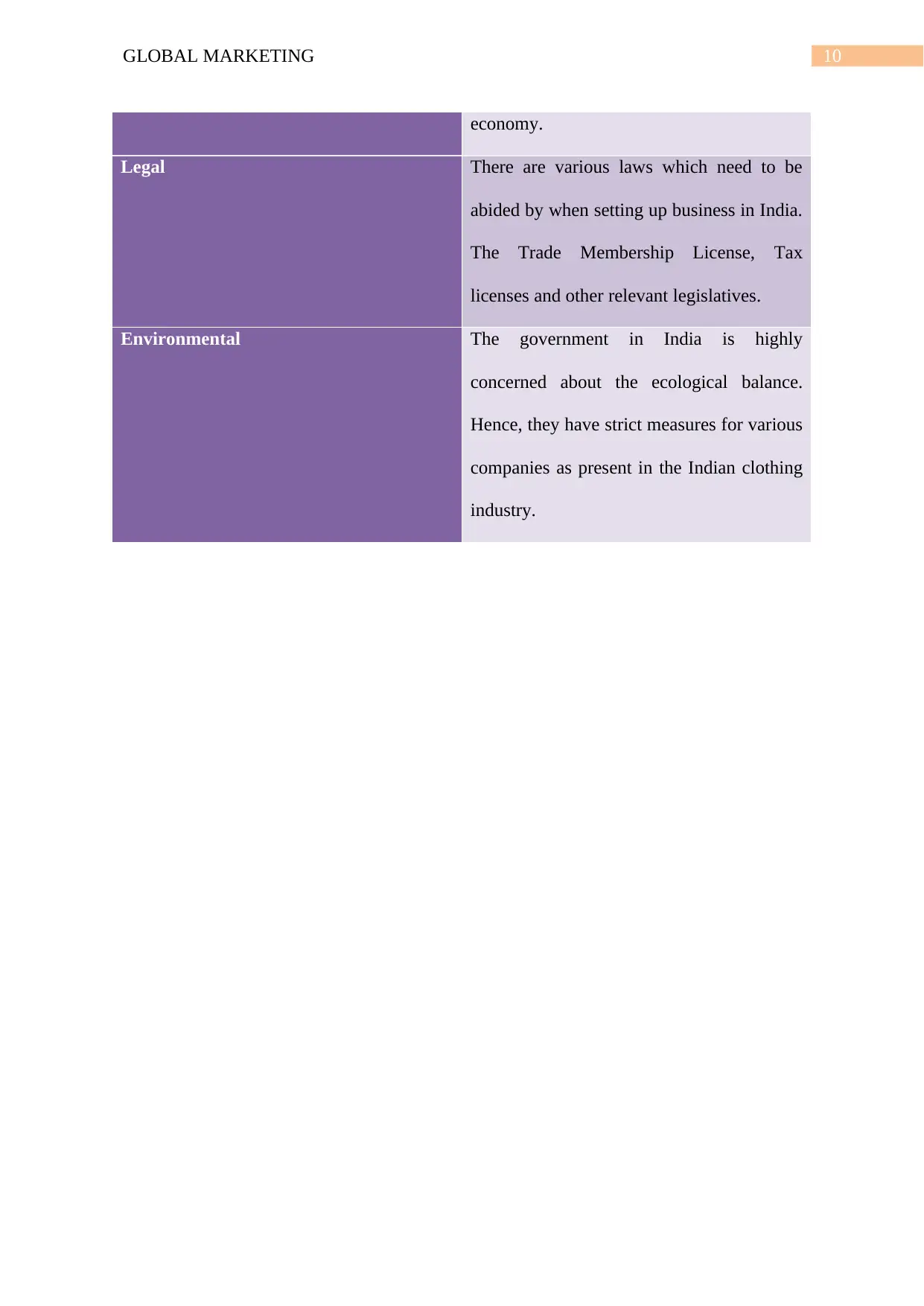
10GLOBAL MARKETING
economy.
Legal There are various laws which need to be
abided by when setting up business in India.
The Trade Membership License, Tax
licenses and other relevant legislatives.
Environmental The government in India is highly
concerned about the ecological balance.
Hence, they have strict measures for various
companies as present in the Indian clothing
industry.
economy.
Legal There are various laws which need to be
abided by when setting up business in India.
The Trade Membership License, Tax
licenses and other relevant legislatives.
Environmental The government in India is highly
concerned about the ecological balance.
Hence, they have strict measures for various
companies as present in the Indian clothing
industry.
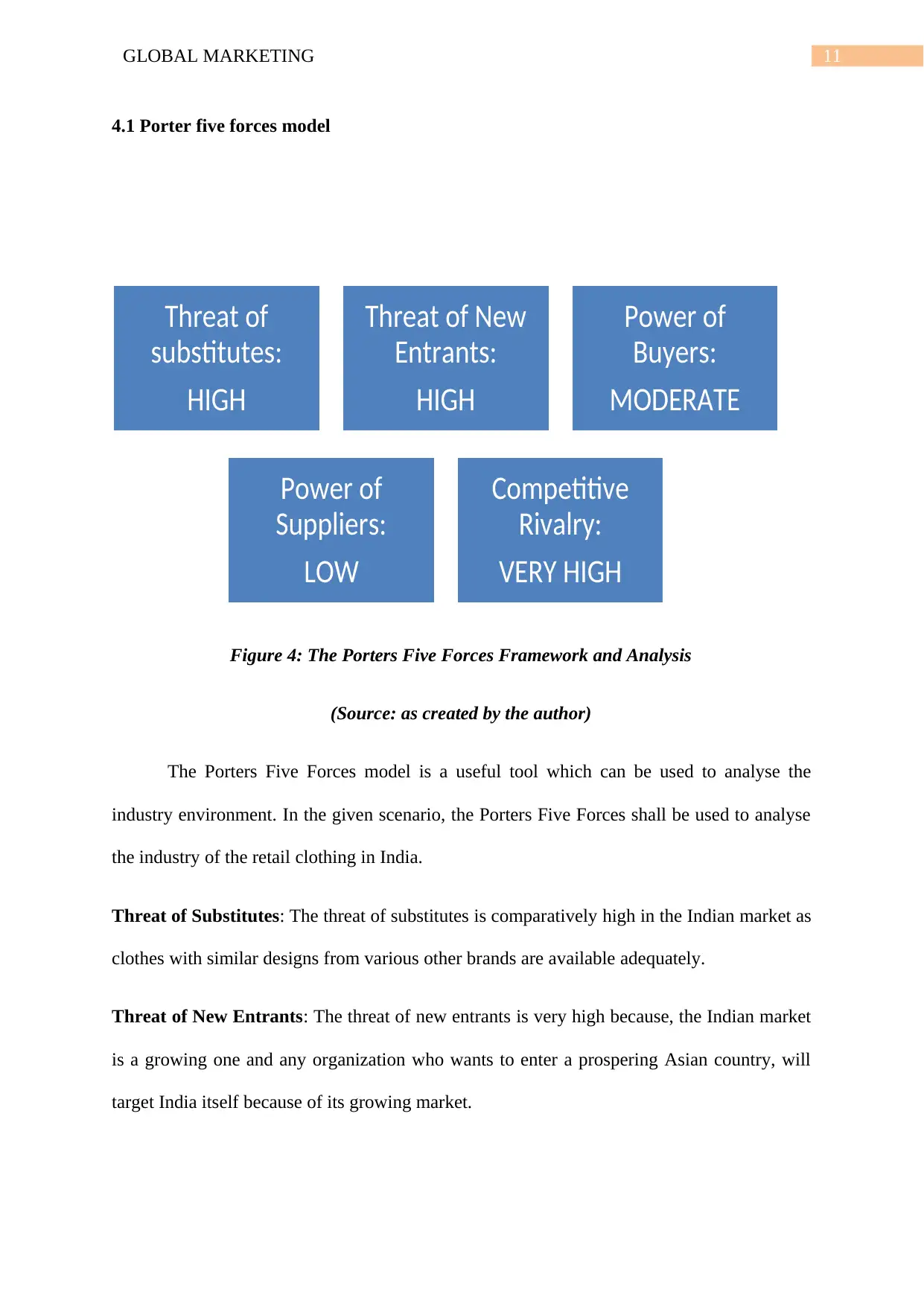
11GLOBAL MARKETING
4.1 Porter five forces model
Figure 4: The Porters Five Forces Framework and Analysis
(Source: as created by the author)
The Porters Five Forces model is a useful tool which can be used to analyse the
industry environment. In the given scenario, the Porters Five Forces shall be used to analyse
the industry of the retail clothing in India.
Threat of Substitutes: The threat of substitutes is comparatively high in the Indian market as
clothes with similar designs from various other brands are available adequately.
Threat of New Entrants: The threat of new entrants is very high because, the Indian market
is a growing one and any organization who wants to enter a prospering Asian country, will
target India itself because of its growing market.
Threat of
substitutes:
HIGH
Threat of New
Entrants:
HIGH
Power of
Buyers:
MODERATE
Power of
Suppliers:
LOW
Competitive
Rivalry:
VERY HIGH
4.1 Porter five forces model
Figure 4: The Porters Five Forces Framework and Analysis
(Source: as created by the author)
The Porters Five Forces model is a useful tool which can be used to analyse the
industry environment. In the given scenario, the Porters Five Forces shall be used to analyse
the industry of the retail clothing in India.
Threat of Substitutes: The threat of substitutes is comparatively high in the Indian market as
clothes with similar designs from various other brands are available adequately.
Threat of New Entrants: The threat of new entrants is very high because, the Indian market
is a growing one and any organization who wants to enter a prospering Asian country, will
target India itself because of its growing market.
Threat of
substitutes:
HIGH
Threat of New
Entrants:
HIGH
Power of
Buyers:
MODERATE
Power of
Suppliers:
LOW
Competitive
Rivalry:
VERY HIGH
⊘ This is a preview!⊘
Do you want full access?
Subscribe today to unlock all pages.

Trusted by 1+ million students worldwide
1 out of 24
Related Documents
Your All-in-One AI-Powered Toolkit for Academic Success.
+13062052269
info@desklib.com
Available 24*7 on WhatsApp / Email
![[object Object]](/_next/static/media/star-bottom.7253800d.svg)
Unlock your academic potential
Copyright © 2020–2025 A2Z Services. All Rights Reserved. Developed and managed by ZUCOL.





